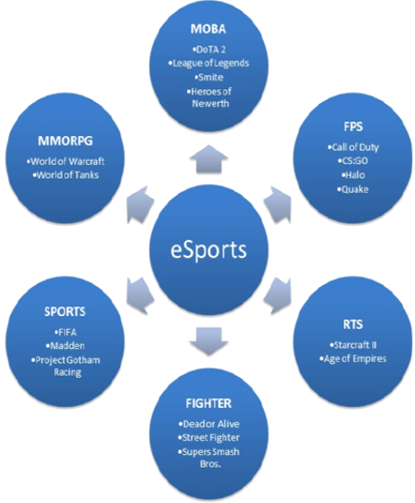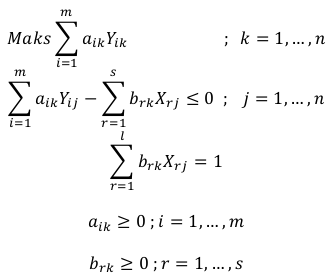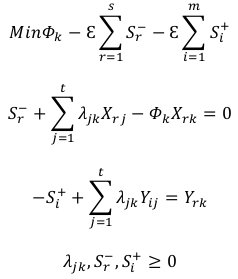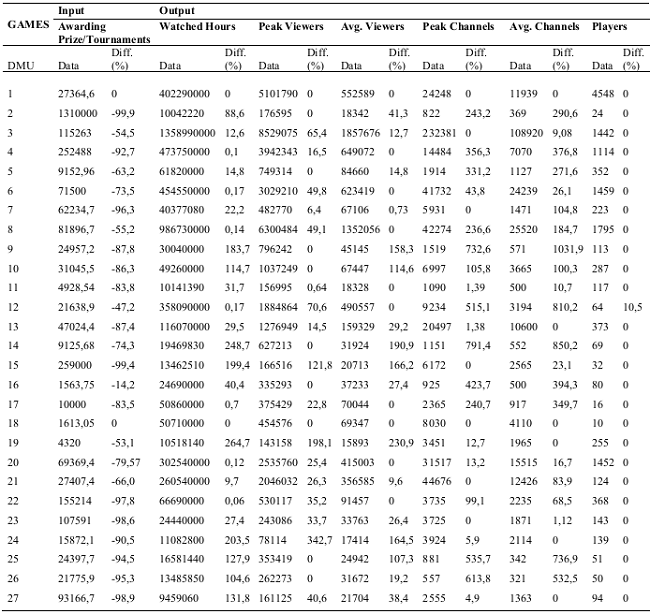INTRODUCTION
It has been an important factor in the individual and relational success of team players in tournaments organized since ancient times. In most of the studies on the subject in the literature, this situation has been examined in detail. However, the effectiveness of the tournaments organized today includes different factors as well as the success power of the teams participating in the tournament. For example, the viewing rate of a tournament is very important as it will increase advertising revenues. This factor is directly related to the large number of teams participating in the tournament. Considering such factors, it is a preliminary information for inactive tournaments by determining the most active games in tournaments. When the literature is examined from this point of view, very few studies can be found. Just at this stage, it is possible to use many possibilities that today's technology gives us. In particular, DEA is an important tool in determining the most effective games according to the factors determined within the games. In this way, by identifying the games with high efficiency, suggestions can be made to increase the effectiveness of other games according to these games. For this reason, it is important to examine the digital games that date back to the 1940s, which have turned into eSports tournaments today, from this point of view, in order to increase the effectiveness of the tournaments.
The history of digital games called computer games or video games dates back to the 1940s. The first interactive game 'Spacewar' was developed in 1962 by MIT (Massachusetts Institute of Technology). In 1972, the 'Pong' game that could be connected to TV, was put on the market and opened the way for people from all walks of life to access digital games. In 1992, the first 3D game 'Wolfenstein' was introduced to the gaming market, followed by the 'Doom' game, so FSP (first-person shot) games entered our lives and computer sales increased considerably (Yılmaz et al., 2004). With the Internet, games around the world have become online. As a result, games have ceased to be single-player and have become multiplayer. The resulting competition elements and the reward platform led players to gather in various game groups (Coşkun et al., 2016). In 1993, with the FSP game called Doom, teams started to compete in online tournaments. In 1997, the Cyberathlete Professional League was established in the United States. In 1999, Counter-Strike introduced a new era of competitive games. With the developments in the West, real-time strategy games and MMORPG (massively online role-playing games) began to develop in South Korea in the 90s (Wagner, 2006). Electronic Sports (eSports) can be defined as a field played by various modes of competitive multiplayer digital games, which are introduced as a new form of sport and played online or offline, individually and/or as a team via Computer / Console / Mobile platforms. Each country classifies eSports differently as a sport, a game, or an intelligence sport (Youth research newsletter, 2018).
Wagner defined eSports as sports activities that develop and train mental and physical abilities using people's information and communication technologies (Wagner, 2006). Hamari and Sjöblom (2015) defined eSports as the simplified form of primary aspects of sport by electronic systems. Electronic sport is a sport that has both physical and mental features. eSports differ from traditional sports due to its ability to be applied individually and as a team, to require tools and equipment specific to its nature, to be performed from all ages, genders, climatic conditions, and to participate in more than one game (Argan et al., 2006).
Today, many eSports tournaments are organized all over the world. The best known are the World Cyber Game, the European Nations Championship, the International Premiership Series, and the Esl Pro Series. In these tournaments, there are subcategories such as adventure, role play, FSP, sports, war, action, simulation, and strategy (Argan et al., 2006). Among the most popular eSports games are Counter-Strike, Dota 2, League of Legends, StarCraft 2, Super Smash Bros and Street Fighter (Çolak et al., 2018; Parshakov et al., 2015).
It is very important to evaluate the competition between the games statistically by evaluating the earnings offered by the eSports games to the participants and to eliminate the deficiencies of the games based on the defined variables. At this stage, many factors need to be taken into account in ranking the games from the best to the worst. In this respect, the games examined in this study were subjected to a multi-factor ranking by defining the input and output variables, and the factors that needed improvement of the inefficient ones according to the efficient games were determined. It is important to improve these factors in increasing the success ranking of the games.
Types of eSports
MOBA (Massively Online Battle Arena): Two competing teams, usually five people, try to destroy each other's energy resources on a map.
FPS (First Person Shot): The player sees the digital game environment through the eyes of the virtual character. Features such as reflex, quick decision making, team management are essential for success in this type of game.
RTS (Real-Time Strategy): In this type of game, the player manages the resources correctly and establishes an army and tries to defeat the opponent's armies.
Fighter: The player tries to defeat the virtual characters chosen by other players, representing a certain martial discipline. It is commonly played as a player versus a player.
Sports: It is a form of traditional sports adapted to virtual environment.
MMORPG (Massively Multiplayer Online Role-Playing Game): They are role-playing games played by connecting to any server.
In the eSports games shown in Figure 1, they have to show different performances to win according to the games. For example, while speed and correct decision is effective in one game, using resources effectively in another game is more effective in winning the game. To connect to any server and get a better idea of what eSports is, it is necessary to understand the eSports ecosystem. Game Companies, Competitions, Teams, Platforms, Players, Brands, Fans are defined as actors in the eSports ecosystem.
In eSports, each game and tournament sets its own rules. eSports offer many career opportunities such as professional athletes, coaches, referees, publishers, analysts, human resources, organizers, event managers, financing, and lawyers (Youth research newsletter, 2018).
In 1962, the first analog game was accepted as Spacewar by Steve Russel and colleagues at the Massachusetts Institute of Technology (Akbulut, 2009).
The presence of digital games in different environments increases diversity. Digital games are a kind of game that derives from the differentiation of the environment. It includes Atari games, computer games, console games, mobile games, and all different genres. In this context, digital gaming has become an individual communication environment that incorporates features such as digitality, interactivity, virtuality, variability, and modularity (Coşkun et al., 2016).
As the popularity of computer games has increased, the number of players has increased. This determines the profits of the industry. However, since e-sports is a young industry, there are not many academic articles on this subject. Although the data show that strong country disparities are influential on players' success, to our knowledge, no research examines the difference in country players' earnings (Parshakov, 2018).
Although the scientific significance of eSports has been emphasized more than a decade ago, academic research on this topic is relatively sparse. Only a small number of studies have addressed aspects of content production. Studies in game design aim to improve the user interface of eSports games (Block et al., 2018).
In this study, efficiency analysis was conducted by considering 27 games that are ranked in the top 200 games on the e-charts website in 2018 (Esports charts, 2019). With this analysis, the efficiencies and changes of efficiencies of the games in 2018 were tried to be obtained. The reasons for ineffectiveness were determined and it is aimed to develop future targets. In Classic Data Envelopment Analysis models, prize money given per tournament is considered as input variables; hours of watch, peak viewer, average viewer, peak channels, average channels, and players were determined as output variables. In the second part, data envelopment analysis is given. In the third part analysis, results, and in the last part discussion are given.
MATERIAL AND METHODS
In a production area, a production function can be formed by using regression equations using input and output data. However, this function is the product of a parametric approach that shows how much output can be achieved on average with a given input. However, the main objective is to achieve maximum output with a certain input in the production function in efficiency measurements. In this respect, the regression equation obtained by the Least Squares method is technically inadequate. The non-parametric linear programming-based DEA method is used frequently to overcome this deficiency. This method is able to evaluate a multi-input and multi-output production process and determine the appropriate efficiency components with the theoretical infrastructure of the production economy (Tarım, 2001). In addition, DEA determines the effective ones among DMUs and makes comparisons according to these DMUs. It was first introduced in the literature by Farrell in 1957. In the following years, it was tried to be developed by different researchers. It was examined in detail by Charnes, Cooper, and Rhodes in 1978 and has taken its current form (Charnes et al., 1978).
The DEA method was first used by Charnes, Cooper, and Rhodes (CCR), and later, the model (BCC) was developed by Banker, Charnes, and Cooper. The DEA analyzes according to a method leading to the frontiers rather than the central tendency (mean values) and involves the creation of a linear surface that can grasp the observed extreme values. The most important feature of this method is the ability of decision units to determine the level and source of inefficiency. Input and output-oriented efficiency analysis can be performed in two stages and it is preferred by economists, industrial engineers, and managers (Charnes et al., 1994).
The decision unit constituting the efficiency limit is determined and summarizes the status of each unit as a relative efficiency score.
The distance or inefficiency levels of inefficiency units to the frontier are determined with reference to the specified efficiency limit, and decision-makers can develop their situation with objectives that will improve their situation with reference units.
DEA is a convenient way to analyze existing data appropriately to help individual decision-makers build the best organization and generate new managerial and theoretical ideas by identifying the best frontier values. The advantages of this method and the results that can be obtained are given as follows (Charnes et al., 1994),
Gives results based on individual observations as opposed to mean density,
Determines the source of ineffectiveness by determining effective and ineffective decision units,
Providing the optimal input combination as a single total value to produce the desired outputs,
It helps to identify the units that will make reference to inefficient decision units,
Simultaneously use multiple inputs and outputs sets or even dummy variables in calculations,
DEA calculations give appropriate results for exogenous changes,
Does not require the production relationship to be limited to the functional form,
Determine the most appropriate criteria for the relative development of each decision unit.
The number of decision units with s input and m output should not be less than n = m + s + 1 and the decision-making unit should be at least twice the number of variables (Boussofiane et al., 1991). The output-input ratio that satisfies the maximization condition can be expressed mathematically as follows (Cooper et al., 2000),
Some disadvantages of the DEA method can be listed as follows (Perman, 1991),
DEA is very sensitive to measurement errors since it is based on the maximum frontier technique,
Although it is sufficient to measure the performance of decision-making units, it is insufficient in terms of absolute effectiveness assessment,
Does not allow the use of statistical test tools as a non-parametric technique,
It can perform a static or comparative static analysis, not suitable for dynamic analysis,
Large-scale problems may take a long time to be solved unless appropriate and convenient package programs are used.
Charnes, Cooper, Rhodes (CCR)
CCR is a basic DEA model developed by Charnes, Cooper, Rhodes. The input-oriented CCR is related to how much input is reduced to achieve the desired output. Output-oriented CCR is related to how much output level will increase with the amount of input available.
RESULTS
In this study, efficiency analysis was conducted by considering 27 games that are ranked in the top 200 games on the e-charts website in 2018 (Esports charts, 2019). With this analysis, the efficiencies and changes of efficiencies of the games in 2018 were tried to be obtained. In this study, efficiency analysis was conducted by examining 27 games from eSports games whose data can be reached on the e-charts website in 2018.
The input used in the analysis is the awarding prize per tournament. Outputs; players, hours of watch, peak viewers, average viewers, peak channels, average channels. The output-oriented model was evaluated using DEA EXCEL SOLVER. The efficiency values of eSports games and the ranking among themselves are given in Table 1. The actual data and improvements of the eSports games as a percentage difference are given in Table 2.
In Table 1, 27 games included in the research are listed according to their efficiency score. In addition, Counter-Strike: GO and Minecraft are efficient games. The other 25 games are listed according to these two games. Counter-Strike: GO and Minecraft games are followed by Warcraft III, Hearthstone, Osu! games.
In Table 2, the comparisons of the other 25 games against the two efficient games are given. The outputs obtained in response to the awarding prize selected as input are shown in Table 2. According to the results of the research: CS and Minecraft were determined to be effective games (Efficiency score = 1). Since the other 25 games are inefficient, the target values for these games are shown in Table 1. According to the findings: the top five games include Counter-Strike, Minecraft, Warcraft III, Hearthstone, and Osu! games. For Warcraft III to be effective, it should reduce the awarding price by 14%; it should increase watched hours by 40.4%, average viewers by 27.4%, peak channels by 423.7%, average channels by 394.3%. For Hearthstone to be effective, it should reduce the awarding price by %47.2 %; it should increase watched hours by 0.17%, peak viewers by 70.6%, peak channels by 515.1%, average channels by 810.2%, players by 10.5%. For Osu! to be effective, it should reduce the awarding price by 53.1%; it should increase watched hours by 264.7%, peak viewers by 198.1%, average viewers by 230.49, peak channels by 12.7%. Improvements for other ineffective games to be effective are given in Table 2.
DISCUSSION
In this study, 27 games in the eSports game sector were evaluated by using DEA. The results of the efficiency analysis were obtained using CCR-I. Many researchers have studied the performance of players (both professional and non-professional players) in the field of eSports (Khromov et al., 2019), the effect of country levels for a single game (Parshakov, 2018). However, eSports games are quite complex today and many variables affect game performance. In this respect, when we consider the e-sports games as a whole, we see a complex structure. Analysis of this structure is possible by comparing the performance of the game by properly defining the relevant variables. In this respect, the study is completely different from other studies in the literature. In this study, we have obtained striking results by considering popular eSports games and important variables. As a result, when eSports games are compared with each other, it is focused on which variables of other games should be improved according to the games that are effective from the numerical values in Table 2.
Sport is an activity that can be done individually or as a team. Team sports have been the focus of attention of people since ancient times. For this reason, sports tournaments organized in every age have succeeded in bringing large communities together. With the developing technology, sports games can also find players and audiences in virtual environments. Today, eSports tournaments held in the virtual environment continue to be the focus of attention with the opportunities they offer to the participants. While there is a group of players who choose eSports as a profession, there is also a group of players who participate in these eSports games as amateurs. Most of the participants in eSports games are amateur participants. For such participants to decide to participate in an eSports tournament, it is an important factor that they carry the psychology that they can compete with the professional athletes participating in the tournament. This important factor can reduce the participation of amateur participants in tournaments where prize money is very high. Therefore, due to the lack of amateur participants in eSports games, factors such as the time of watching the tournament, the number of viewers, the number of channels watched, and the number of players affect the decrease. This fact can be observed in the study. Some numerical values given in the results of the study emphasize that the prize money of the eSports games that were effective in the 27 eSports tournaments discussed in the study is less than the other 27 tournaments. In addition, the conclusion that the prize money should be reduced in order to increase the efficiency of the other teams participating in the tournament is an important finding obtained from the research. One of the important factors in eSports games is the high participation rate. In particular, according to the information presented in reference (Parshakov, 2018), it is said that "a 1% increase in prize money causes an increase of 2.2% per player". In such a case, the increase in the prize money does not cause an increase in the participant, on the contrary, it causes a decrease in the participant and an increase in the prize money per capita. In this case, the effectiveness of the eSports game decreases. Evaluation of eSports games in terms of effectiveness is not common in other studies on this subject. In the studies on the subject in the literature, the characteristics that affect the success of the players in eSports tournaments were examined, as in the reference (Pérez-Rubio et al., 2017; Rodríguez González et al., 2018).























